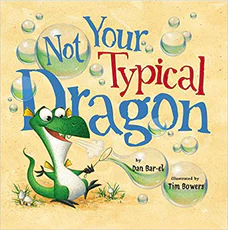Not Your Typical Dragon
Written by Dan Bar-el
Illustrated by Tim Bowers
40 pages
•
Published 2013 (Viking Books for Young Readers)

Recommended Age Range: Kindergarten through 3rd grade.
Publisher's Summary:
Everybody knows your typical dragon breathes fire. But when Crispin tries to breathe fire on his seventh birthday, fire doesn’t come out—only whipped cream! Each time Crispin tries to breathe fire, he ends up with Band-Aids/ marshmallows/ teddy bears? Crispin wonders if he’ll ever find his inner fire. But when a family emergency breaks out, it takes a little dragon with not-so-typical abilities to save the day. With wry humor and whimsical illustrations, Not Your Typical Dragon is the perfect story for any child who can’t help feeling a little bit different.

Dr. Annie's Takeaways
Recommended for: This book is a fun read for any kid who has ever been criticized for being unique or different. It celebrates differences and pokes fun at adults who want their children to be “typical.” The metaphor of the story could apply to many scenarios, but it could be a particularly good fit for kids who are neurodiverse (e..g., autism, ADHD) or LGBTQIA and need a light-hearted reminder that their differences are assets rather than flaws (who wouldn’t love to hang out with a dragon who breathes whipped cream rather than fire?!).
Would a child like it? It’s a silly book about a marshmallow breathing dragon who saves the day. Lots of kids will enjoy this book.
Tone: Silly, uplifting
Story Quality: This story about the value of being unique has something of a Rudolph the Red-Nosed Reindeer plotline (i.e., young protagonist is rejected for being different, but in the end his difference saves the day and is celebrated by his community), but it brings its own sense of humor and heart to the story. It’s fun to think about a dragon breathing things other than fire, and it reinforces the message to caregivers and kids that children’s unique characteristics and differences should be celebrated rather than criticized.
Illustrations: Fun, energetic illustrations with a lot of detail and texture.
Representation: Crispin is a male dragon who breathes everything but fire (marshmallows, teddy bears, bubbles). He has a mother and a father dragon who are critical of his inability to breathe fire. Crispin befriends a knight, Sir George, who is a White teenage or young adult male. The knight has a father who is critical of him for not finding a fire-breathing dragon. There is a theme here of fathers criticizing their male offspring for not being aggressive enough, and it ends with the fathers realizing they were wrong and celebrating their kids for their strengths.
Psychological Practices: This story makes the point that it isn’t always better to do things just the same as everyone else and that differences are necessary and important. Throughout the book, Crispin breathes things that are helpful and fun, but no one appreciates this because it’s not “typical” dragon behavior. Crispin tries his best to breathe fire, but he isn’t able to. Everyone has suggestions for how to “fix” Crispin (eating spicy food, taking medicine, having an angry attitude, relaxing), but nothing works. He finally runs away from home because he is so afraid of disappointing his family. He befriends a knight, Sir George, who is also afraid of disappointing his family because he doesn’t want to fight. The two travel back to Crispin’s home, where Sir George and Crispin’s dads get into an aggressive altercation, during which Crispin’s dad accidentally sets the family’s home on fire. Crispin saves the day by breathing a stream of water. This makes his father see that Crispin’s difference is special, and he stops trying to make him a “typical dragon.” It is an obvious metaphor for any child who has falsely been told that their difference is wrong/bad/broken, and it celebrates the importance of being oneself and being unique.
Concerns: The gender roles in this book are quite toxic (e.g., dads trying to force their male children to be aggressive; the one female character frets and worries what the neighrbors will think). The author is at least mostly aware of this–we’re supposed to view the parents’ behavior critically and recognize the strengths of the main protagonists. However, if I were reading this with a child who could be influenced by the parents’ comments and behavior, I would want to clarify this.
